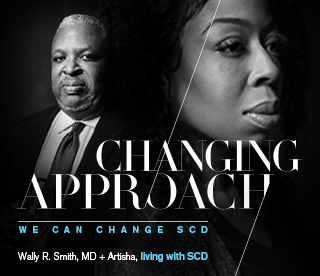

Available treatments for SCD
Allogeneic HSCT
Allogeneic hematopoietic stem cell transplantation (HSCT) is currently the only curative option for treatment of SCD. Allo-HSCT requires a human leukocyte antigen (HLA)-matched donor; thus, availability remains limited.1 Less than 15% of patients with sickle cell disease in the US have a matched sibling donor.2
Since 1984, approximately 1200 patients have undergone allo-HSCT.3 Outcomes have shown that, in allo-HSCT with an HLA-identical sibling donor, more than 90% of the patients with sickle cell disease who underwent successful transplant were cured (defined as survival with sustained donor cell engraftment and either complete or partial normal erythropoiesis).4
Historically, better survival outcomes have been achieved with younger patients who were transplanted before developing progressive organ damage. Due to treatment-related mortality that can increase with age, guidelines recommend that young patients with sickle cell disease who have an HLA-matched sibling donor should be transplanted as early as possible.

The latest guidelines for allo-HSCT in SCD calls for the consideration of the risks and benefits for each individual patient, which factors in the progression and impact of the disease over the course of their life. Considerations also include the patient's overall health status and history of specific SCD-related complications.5 Allo-HSCT has been recommended for patients with stroke or abnormal Doppler transcranial ultrasound, as well as for those with acute chest syndrome and/or recurrent pain crises when standard-of-care therapies have been unsuccessful.6
In recent years, approaches such as reduced toxicity conditioning and half-matched (haploidentical) donors have been studied to help expand transplant eligibility for a larger patient population, including adults.7
How allogeneic HSCT works
When a patient with SCD is able to find a matched donor, the donor’s hematopoietic stem cells (that contain a functioning HBB gene) can be transplanted into the patient. Patients will need to undergo chemotherapy conditioning prior to transplanting the donor cells, which will then be able to engraft in their bone marrow.6,7
Risks of allo-HSCT
There are inherent risks associated with allogeneic HSCT, including1:
- Transplant-related mortality
- Severe immunological complications, such as graft versus host disease (GVHD)
- Graft rejection
- Infection
It is important to consider the risks and benefits of any treatment, including allo-HSCT.
Red blood cell transfusions
Patients on chronic transfusions may receive chelation therapy to manage iron levels; however, iron overload can still occur in multiple organs and iron overload–induced organ damage has the potential to become fatal.8,9
Pharmacological treatments
Current available treatments mainly focus on managing acute symptoms and complications of SCD. The pharmacologic treatments that are currently available can reduce the frequency of pain crises and the need for blood transfusions.10,11
These treatments aim to reduce pain crises, reduce acute complications, or improve Hb levels.12-14
A current, approved standard treatment for patients with SCD is a daily, oral treatment, first used to treat SCD in 1984, that has been clinically studied for more than 35 years in both adult and pediatric patients.15 This treatment works by increasing the production of fetal hemoglobin and total hemoglobin (Hb) levels to help reduce the frequency of vaso-occlusive events and blood transfusions.16 Despite being a standard treatment for SCD, it is widely noted that patients have a variable response to treatment due to the heterogeneity of the disease.15
In recent years, the FDA has approved several treatments for SCD, representing advances that haven’t occurred in decades. These pharmacologic treatments are administered daily or monthly and aim to provide these therapeutic effects16,17:
- Reduce hemolysis and anemia through inhibiting HbS polymerization17
- Inhibit endothelial cell interaction and downstream RBC clustering that leads to vaso-occlusion17
- Reduce oxidative stress and decrease adhesion of sickled RBCs17
Research in Sickle Cell Disease
Clinical research continues to explore ways to address unmet needs in managing and treating sickle cell disease. As of May 2022, ClinicalTrials.gov lists nearly 400 completed sickle cell disease clinical studies (interventional and natural history), with over 250 active or actively recruiting trials.18,19 From using newborn screening to establish an SCD care plan from infancy to improving our understanding of the disease and exploring new treatment possibilities, the current goals of clinical research in SCD are both broad and deep.17-20
Some of the developing therapies being investigated today include:
- A type of selective pyruvate kinase-R (PKR) activator—an investigational, oral, once-daily medication that can potentially reduce levels of 2,3-diphosphoglycerate (2,3-DPG)—currently in development for the treatment of sickle cell disease. It is designed to help increase functioning hemoglobin, improve red blood cell health, and decrease hemolysis and vaso-occlusive crises (VOCs).21
- Another PKR activator for adults with sickle cell disease—an investigational, oral small molecule. It can potentially reduce the levels of 2,3-DPG and increase adenosine triphosphate (ATP) production, which may help reduce hemolysis and red blood cell sickling.22
- A potential antibody-based therapy that blocks P-selectin to help reduce vaso-occlusive crises (VOCs) in patients with sickle cell disease.23
Please note, this list is not comprehensive of all therapies in development for sickle cell disease.


Despite all the complications sickle cell disease can cause, our role and our goal is to partner with patients to try to prevent as much from happening as we can. The future looks bright.”
Abena O. Appiah-Kubi, MD, MPH
New therapies are being investigated that focus on treating
SCD at the genetic level
New therapies are being investigated that focus on treating SCD at the genetic level
References
1. Kapoor S, Little JA, Pecker LH. Advances in the treatment of sickle cell disease. Mayo Clin Proc. 2018;93(12):1810-1824. 2. Leonard A, Tisdale JF. Stem cell transplantation in sickle cell disease: therapeutic potential and challenges faced. Expert Rev Hematol. 2018;11(7):547-565. 3. Bhatia M, Sheth S. Hematopoietic stem cell transplantation in sickle cell disease: patient selection and special considerations. J Blood Med. 2015;6:229-238. doi:10.2147/JBM.S60515 4. Gluckman E, Cappelli B, Bernaudin F, et al. Sickle cell disease: an international survey of results of HLA-identical sibling hematopoietic stem cell transplantation. Blood. 2017;129(11):1548-1556. doi:10.1182/blood-2016-10-745711 5. Kanter J, Falcon C. Gene therapy for sickle cell disease: where we are now? Hematology Am Soc Hematol Educ Program. 2021;2021(1):174-180. 6. Guilcher GMT, Horan JT. Matched sibling donor hematopoietic stem cell transplantation for sickle cell disease. In: Meier ER, Abraham A, Fasano RM, eds. Sickle Cell Disease and Hematopoietic Stem Cell Transplantation. Springer International Publishing; 2018:251-269. 7. Ware RE, de Montalembert M, Tshilolo L, Abboud MR. Sickle Cell Disease. Lancet. 2017;390(10091):312-323. 8. de Montalembert M, Ferster A, Colombatti R, Rees DC, Gulbis B; European Network for Rare and Congenital Anaemias. ENERCA clinical recommendations for disease management and prevention of complications of sickle cell disease in children. Am J Hematol. 2011;86(1):72-75. 9. Wood JC, Cohen AR, Pressel SL, et al. Organ iron accumulation in chronically transfused children with sickle cell anaemia: baseline results from the TWiTCH trial. Br J Haematol. 2016;172(1):122‑130. 10. Kato GJ, Piel FB, Reid CD, et al. Sickle cell disease. Nat Rev Dis Primers. 2018;4:18010. 11. Mayo Clinic. Sickle cell anemia - Diagnosis and treatment. Published 2018. Accessed May 26, 2022. https://www.mayoclinic.org/diseases-conditions/sickle-cell-anemia/diagnosistreatment/drc-20355882 12. ENDARI™ (L-glutamine oral powder) [package insert]. Torrance, CA: Emmaus Medical, Inc; 2017. 13. ADAKVEO® (crizanlizumab) [package insert]. East Hanover, NJ: Novartis Pharmaceutical Corporation; 2019. 14. OXBRYTA™ (voxelotor) [package insert]. San Francisco, CA: Blood Therapeutics, Inc; 2019. 15. Ware RE. How I use hydroxyurea to treat young patients with sickle cell anemia. Blood. 2010;115(26):5300-5311. 16. Agrawal RK, Patel RK, Shah V, Nainiwal L, Trivedi B. Hydroxyurea in sickle cell disease: drug review. Indian J Hematol Blood Transfus. 2014;30(2):91-96. 17. Salinas Cisneros G, Thein SL. Recent Advances in the Treatment of Sickle Cell Disease. Front Physiol. 2020;11:435. doi:10.3389/fphys.2020.00435 18. ClinicalTrials.gov. Completed Studies | Sickle Cell Disease. Accessed May 5, 2022. https://bit.ly/3wSKbC5 19. ClinicalTrials.gov. Accessed May 26, 2022. https://clinicaltrials.gov/ct2/results?cond=sickle+cell+anemia+and+disorders&Search=Apply&recrs=b&recrs=a&recrs=f&recrs=d&age_v=&gndr=&type=&rslt= 20. CDC Grand Rounds: Newborn Screening and Improved Outcomes. www.cdc.gov. Accessed May 5, 2022. https://www.cdc.gov/mmwr/preview/mmwrhtml/mm6121a2.htm 21. Schroeder P, Fulzele K, Forsyth S, et al. Etavopivat, a pyruvate kinase activator in red blood cells, for the treatment of sickle cell disease. J Pharmacol Exp Ther. 2022;380(3):210-219. doi:10.1124/jpet.121.000743 22. Al-Samkari H, van Beers EJ. Mitapivat, a novel pyruvate kinase activator, for the treatment of hereditary hemolytic anemias. Ther Adv Hematol. 2021;12:20406207211066070. 23. Mayer C. Preliminary results of a phase 1 study in healthy subjects administered Inclacumab, a fully human IgG4 anti-P-Selectin monoclonal antibody in development for treatment of sickle cell disease. Poster presented at: American Society of Hematology (ASH) Annual Meeting & Exposition; December 10-14, 2021; Atlanta, GA. Published December 11, 2021. Accessed May 25, 2022. https://ash.confex.com/ash/2021/webprogram/Paper153370.html

